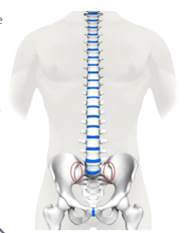The SI Joint and Human Health
The Sacroiliac Joint: A Core Component of Human Health
The study of biomechanics offers the potential to improve human health by understanding the interconnectedness of the musculoskeletal system. While the body is a complex system, the sacroiliac joint (SIJ) is a critical part that has been overlooked for far too long.
As a central hub for both motion and shock absorption, the SIJ plays a vital role in overall health and can be a significant source of back pain when dysfunctional.
 While the lumbar spine is often targeted in the treatment of back pain, the sacroiliac joint (SIJ) is appearing as a primary driver of these issues. Recent research suggests that SIJ dysfunction can:
While the lumbar spine is often targeted in the treatment of back pain, the sacroiliac joint (SIJ) is appearing as a primary driver of these issues. Recent research suggests that SIJ dysfunction can:
- Coexist with disc herniations
- Be the underlying cause of disc herniations
It’s crucial for healthcare providers to consider the SIJ as a potential source of back pain and to incorporate appropriate diagnostic and treatment strategies.
The Serola Sacroiliac Belt: A Simple Screening Tool for SIJ Dysfunction
While lumbar disc herniation stays a common diagnosis, the role of the sacroiliac joint (SIJ) in back pain is often overlooked. The Serola SI Joint Belt offers a simple and cost-effective method to screen for SIJ dysfunction. By reducing pain, the belt can provide strong evidence that the SIJ is a significant contributor to a patient’s symptoms. Healthcare providers should consider incorporating this tool into their clinical practice to find patients who may benefit from targeted SIJ treatment.
The Serola Theory: A New Perspective on Musculoskeletal Biomechanics
Dr. Serola’s extensive research in biomechanics has led to the development of the Serola Theory. This theory offers a novel perspective on the integration of the musculoskeletal system, focusing on areas often overlooked in traditional research. By understanding the underlying biomechanical principles, healthcare professionals can gain valuable insights into the diagnosis and treatment of musculoskeletal disorders.
Types of Pain Relief
Hip Pain and The SI Joint – The Serola Sacroiliac Belt:
A Solution for Hip Pain Hip pain can often be misdiagnosed due to its ability to manifest in various parts of the body, including the lower back, neck, and legs. This pain often arises from ligament strain or tears in the pelvic region, leading to instability and discomfort.
The Serola Sacroiliac Belt offers a non-invasive solution by providing external support to the SI joint. By stabilizing the joint and reducing muscle strain, the belt can significantly alleviate hip pain and improve overall mobility. Healthcare providers may consider recommending the Serola Belt to patients experiencing hip pain as a conservative treatment choice.
